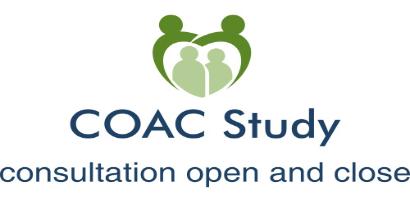Objective
The objective of the Intervention Development study is to design a complex intervention (The Consultation Open and Close Intervention; COAC) to improve the ability of GPs and nurses to address patients’ concerns, incorporating the use of an electronic form completed by patients at consultation opening and a report at consultation closure, which is either printed or accessible from the patient record.
Timescales
October 2019 – October 2020.
Participating practices
Courtside Surgery, Yate
Nightingale Valley Practice, Brislington
Third practice TBC
Methods
- Design of an online questionnaire system using practice SMS/email systems and online survey software to allow patient self-completion of a pre-consultation questionnaire and generation of a report showing low-scoring questionnaire items, which is shared with GPs or nurses.
- Testing the pre-consultation system with 45 patients in 3 rounds, using a person-based approach, with iterative adjustments made based on patient, administrator, receptionist, nurse and GP feedback after each round.
- Design of an electronic template, integrated with the patient record, to provide a printable consultation-closure report to patients on issues raised in the consultation, advice given, treatment, follow-up and “safety-netting” (ensuring patients know what to do if there are any problems with their treatment).
- Testing the consultation-closure report iteratively with 45 patients in 3 rounds, using a person-based approach, with iterative adjustments made based on patient and GP/nurse feedback after each round.
Pre-consultation form
The COAC study will build on a previously developed questionnaire called the Primary Care Outcomes Questionnaire (PCOQ). The PCOQ was designed to measure outcomes from primary care which matter to patients, and which GPs can influence. It is therefore an ideal starting point for development of the COAC pre-consultation questionnaire. The health centre send out a text to the patient just before their consultation with a link to the form. After the patient completes this, it is uploaded to the patient records system, and the GP can then access it before the consultation.
This process is shown in the figure below
Consultation Closure Report
The report is currently under development. It will have four sub-headings as follows:
- Issues raised in the consultation today
- Advice given
- Treatment
- Follow-up and safety-netting
Emerging Results
Patients are finding that the pre-consultation questionnaire helps focus their mind before the consultation and communicate their problems to the GP more easily. GPs are finding the form does not take up too much time, and may uncover information more quickly than they might have done without the form.
“I think it’s a great study. I feel it could be very relevant … for me I thought it was a great way of getting my symptoms and my feelings across to the doctor before I actually saw her. It sort of saved on time, because we were starting from a point where maybe it would nearly be the end of an appointment.” (Patient)
“I would say it gave me the opportunity to think about what my symptoms were and how they were affecting my life, whereas normally when you just … you go to the doctor, you don’t really reflect on it.” (Patient)
“In a sense it’s [the patient] starting the consultation with themselves before they come in, and you get to quite quickly see what’s in their heads.” (GP)
Intervention Development Study


